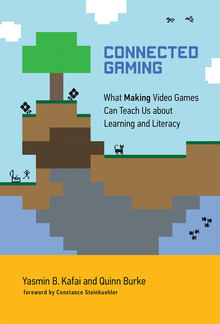 Zusammenfassungen
Zusammenfassungen
 Over the last decade, video games designed to teach academic content have multiplied. Students can learn about Newtonian physics from a game or prep for entry into the army. An emphasis on the instructionist approach to gaming, however, has overshadowed the constructionist approach, in which students learn by designing their own games themselves. In this book, Yasmin Kafai and Quinn Burke discuss the educational benefits of constructionist gaming—coding, collaboration, and creativity—and the move from “computational thinking” toward “computational participation.”
Over the last decade, video games designed to teach academic content have multiplied. Students can learn about Newtonian physics from a game or prep for entry into the army. An emphasis on the instructionist approach to gaming, however, has overshadowed the constructionist approach, in which students learn by designing their own games themselves. In this book, Yasmin Kafai and Quinn Burke discuss the educational benefits of constructionist gaming—coding, collaboration, and creativity—and the move from “computational thinking” toward “computational participation.”
Kafai and Burke point to recent developments that support a shift to game making from game playing, including the game industry's acceptance, and even promotion, of “modding” and the growth of a DIY culture. Kafai and Burke show that student-designed games teach not only such technical skills as programming but also academic subjects. Making games also teaches collaboration, as students frequently work in teams to produce content and then share their games with in class or with others online. Yet Kafai and Burke don't advocate abandoning instructionist for constructionist approaches. Rather, they argue for a more comprehensive, inclusive idea of connected gaming in which both making and gaming play a part.
 Dieses Buch erwähnt ...
Dieses Buch erwähnt ...
 Personen KB IB clear | Frederick P. Brooks , Jane Margolis , Lee Martin , Sherry Turkle | ||||||||||||||||||||||||||||||||||||
 Begriffe KB IB clear | AgentSheets
, Bildungeducation (Bildung)
, computational participation
, computational thinkingcomputational thinking
,  Computerspiele Computerspiele computer game
, computer game
,  design thinking
, hackathon
, design thinking
, hackathon
,  Lernen Lernen learning
, learning
,  Programmieren Programmieren programming
, programming
,  Spiel Spiel game
, game
,  turtle graphics
, Wearable ComputingWearable Computing
, World of Warcraft
, Zone of Proximal Development turtle graphics
, Wearable ComputingWearable Computing
, World of Warcraft
, Zone of Proximal Development
| ||||||||||||||||||||||||||||||||||||
 Bücher |
| ||||||||||||||||||||||||||||||||||||
 Texte |
|
 Dieses Buch erwähnt vermutlich nicht ...
Dieses Buch erwähnt vermutlich nicht ... 
 Nicht erwähnte Begriffe | AgentCubes, Digitalisierung, LehrerIn, Schule, Unterricht |
 Tagcloud
Tagcloud
 Zitationsgraph
Zitationsgraph
 Zitationsgraph (Beta-Test mit vis.js)
Zitationsgraph (Beta-Test mit vis.js)
 2 Erwähnungen
2 Erwähnungen 
- Proceedings of the Workshop in Primary and Secondary Computing Education, WiPSCE 2015, London, United Kingdom, November 9-11, 2015 (Judith Gal-Ezer, Sue Sentance, Jan Vahrenhold) (2015)
- Constructionist Gaming Beyond the Screen - Middle School Students' Crafting and Computing of Touchpads, Board Games, and Controllers (Yasmin B. Kafai, Veena Vasudevan) (2015)


- Constructionist Gaming Beyond the Screen - Middle School Students' Crafting and Computing of Touchpads, Board Games, and Controllers (Yasmin B. Kafai, Veena Vasudevan) (2015)
- Emerging Research, Practice, and Policy on Computational Thinking (Peter J. Rich, Charles B. Hodges) (2017)


- 24. Computational Participation - Teaching Kids to Create and Connect Through Code (Yasmin B. Kafai, Quinn Burke) (2017)


- 24. Computational Participation - Teaching Kids to Create and Connect Through Code (Yasmin B. Kafai, Quinn Burke) (2017)
 Co-zitierte Bücher
Co-zitierte Bücher
 Volltext dieses Dokuments
Volltext dieses Dokuments
 | Connected Gaming: Gesamtes Buch als Volltext ( : 1854 kByte) : 1854 kByte) |
 | Connected Gaming: Gesamtes Buch als Volltext ( : :  , 4970 kByte) , 4970 kByte) |
 Bibliographisches
Bibliographisches 
 Beat und dieses Buch
Beat und dieses Buch
Beat hat dieses Buch während seiner Zeit am Institut für Medien und Schule (IMS) ins Biblionetz aufgenommen. Beat besitzt kein physisches, aber ein digitales Exemplar. (das er aber aus Urheberrechtsgründen nicht einfach weitergeben darf). Es gibt bisher nur wenige Objekte im Biblionetz, die dieses Werk zitieren.




















 Biblionetz-History
Biblionetz-History